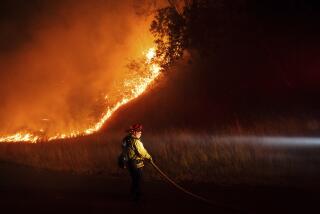Rain, though welcome, brings fire hazards in drought
Conventional wisdom holds that in drought-ravaged California, any hint of rain is considered good news.
But when it comes to forest fires, that sprinkling can cause big problems.
In Northern Californiaâs forests and along the Eastern Sierra, summer thunderstorms bring rain, but they also bring lightning, which can ignite major fires.
Then there is the phenomenon called âfuel reloadingâ â when rainy weather helps sprout new blades of grass and vegetation â followed by a dry spell that turns it all into brush ready to burn.
âItâs a little bit of a paradox.⦠You complain if thereâs no precipitation at all, or if thereâs too much,â said Kelly Redmond, a climatologist with the Western Regional Climate Center at the Desert Research Institute in Reno. âIn some situations, the drought does not necessarily lead to bad fire years in and of its own.â
There have been more than 160 lightning-caused wildfires in 15 of Californiaâs 18 national forests this year, said Stanton Florea of the National Forest Service.
More than half of those ignited in the last week, including the 1,000-acre Saddle fire in the Shasta-Trinity National Forest. Collectively, the blazes have burned more than 5,000 acres.
But officials warn that the Northern California fire season is just beginning and that bigger fires are expected.
Northern Californiaâs forests saw an epic drought-fueled fire season in 2014: Fires consumed more than 350,000 acres of national forest by September, compared to 84,109 acres during the same period in 2013. More than 200 structures were destroyed.
Forests on the eastern Sierra Nevada along U.S. 395 are also vulnerable to a fast-moving wildfire, Redmond said. The pieces were set in place last year, when a series of summer tropical storms in the Pacific reached farther north than normal and encouraged the growth of more vegetation.
As the stateâs drought persists, however, that extra growth is turning into bone-dry tinder, Redmond said.
âWhen the precipitation shuts off in the Central Valley, usually sometime in May or June, the valve is pretty much shut off,â Redmond said. âWeâve seen some reports that because of the heavy precipitation in the Great Basin [earlier this year], grasses are practically up to the underbelly of a horse.â
The area around Mono Lake is especially ripe for a fire, he said.
Grass can lead small blazes toward bigger fuel such as trees that are more difficult to ignite without a persistent source around it. A huge die-out of trees in the Sierra Nevada mountain range is also adding to concerns that thereâs more to burn, said Tom Rolinski, a Forest Service meteorologist.
Many storms that bring rain to Southern California wring out their moisture by the time they reach the northern half of the state, leading to tens of thousands of dry-lightning strikes.
âAnytime you got lightning around and any grass to burn, thatâs not a combination you want to be downwind of,â Redmond said.
Daniel Berlant with the California Department of Forestry and Fire Protection said his agency has reached a maximum staffing of 7,000 firefighters months earlier than normal.
âItâs been a weird weather pattern â anytime we get rain, itâs immediately followed by hot temperatures and even gusty winds,â Berlant said. âThis little rain here or there is nice but itâs not our savior.â
Twitter: @JosephSerna
More to Read
Sign up for Essential California
The most important California stories and recommendations in your inbox every morning.
You may occasionally receive promotional content from the Los Angeles Times.











